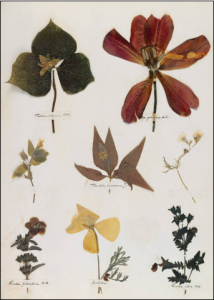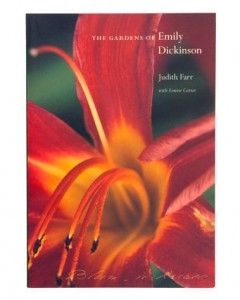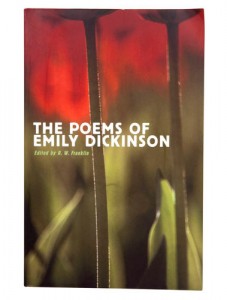Inside The New York Botanical Garden
Judith Farr
Posted in Exhibitions on June 3 2010, by Plant Talk
Gallery Exhibition Delves into Poet’s Love of Nature
 |
Judith Farr is Professor Emerita of English and American Literature at Georgetown University and author of The Passion of Emily Dickinson and The Gardens of Emily Dickinson. |
 It is not widely known that our great American poet Emily Dickinson (1830–1886) was a practiced gardener before she became an accomplished poet. She joined her gentle mother tending the classic contents of a cottage garden—roses, cyclamen, lobelia, tulips, and more—at only 12 years of age while her training under the famous New England educator Edward Hitchcock taught her the elements of botany in childhood.
It is not widely known that our great American poet Emily Dickinson (1830–1886) was a practiced gardener before she became an accomplished poet. She joined her gentle mother tending the classic contents of a cottage garden—roses, cyclamen, lobelia, tulips, and more—at only 12 years of age while her training under the famous New England educator Edward Hitchcock taught her the elements of botany in childhood.
Indeed, nearly half of Dickinson’s lyrical letters to family and chosen friends and over one-third of her brilliantly idiosyncratic poems appeal to nature for the images and themes that render them incisive and unforgettable. Only a few of Emily Dickinson’s poems were printed during her lifetime but many people remembered receiving one of them, often tucked into an exquisite bouquet that she had grown and arranged herself.
Therefore, it is fitting that The New York Botanical Garden presents Emily Dickinson in her reciprocal roles as Poet and Gardener in its exhibition Emily Dickinson’s Garden: The Poetry of Flowers. While an array of the flowers about which she wrote blooms outdoors at the Garden, the LuEsther T. Mertz Library Gallery showcases materials designed to introduce visitors to the life and art of Emily Dickinson. The Gallery Exhibition, which will run to August 1, is built around several significant themes in Dickinson’s life, such as her childhood, her gardening, and her poetry.
Read More
Posted in Shop/Book Reviews on May 20 2010, by Plant Talk
 John Suskewich is Book Manager for Shop in the Garden.
John Suskewich is Book Manager for Shop in the Garden.
 Emily Dickinson was a poet and a gardener, so there is no better place to celebrate the world of words she created than here at The New York Botanical Garden. The exhibition Emily Dickinson’s Garden: The Poetry of Flowers illustrates the many ways in which her horticultural life inspired her poetry, using an evocation of her actual garden, a digital reproduction of her personal herbarium, manuscripts, artifacts, and other material to bring this point into bloom.
Emily Dickinson was a poet and a gardener, so there is no better place to celebrate the world of words she created than here at The New York Botanical Garden. The exhibition Emily Dickinson’s Garden: The Poetry of Flowers illustrates the many ways in which her horticultural life inspired her poetry, using an evocation of her actual garden, a digital reproduction of her personal herbarium, manuscripts, artifacts, and other material to bring this point into bloom.
At Shop in the Garden we are featuring a number of books that show how the poet used plants and flowers as metaphor and image in her art.
The Gardens of Emily Dickinson, by Judith Farr, with a chapter on how to grow Dickinson’s flowers by Louise Carter, is a gardening biography, a florography, of the “Belle of Amherst.” With scholarship and insight, the Farr re-creates the arcadian context of life in small-town America during the mid-19th century, where nature came right up through the picket fence to your front door. The author looks at the poems and letters to see what specific flowers Dickinson gardened with and what specific meanings they had for her. From Indian pipes to jasmine vines, everything in nature could be a symbol. and part of Dickinson’s greatness comes from her ability to distill what she observes into something eternal.
 Two volumes of her poetry show with what mastery and beauty she was able to do this. Poetry for Young People: Emily Dickinson, edited by Frances S. Bolin, selects some of the best loved poems and sets them to charming illustrations by Chi Chung. There is an especially good selection of the riddle poems (but why not “A narrow fellow in the grass…”!)
Two volumes of her poetry show with what mastery and beauty she was able to do this. Poetry for Young People: Emily Dickinson, edited by Frances S. Bolin, selects some of the best loved poems and sets them to charming illustrations by Chi Chung. There is an especially good selection of the riddle poems (but why not “A narrow fellow in the grass…”!)
The Poems of Emily Dickinson: Reading Edition, prepared by Ralph W. Franklin, is a definitive one-volume edition of the extant poems, 1,789 in all, presented with Dickinson’s idiosyncratic spelling, punctuation, and capitalization. What a pleasure to have this great achievement concentrated into an object you can bring anywhere. Short of facsimiles of fascicles, this is the Dickinson volume to own.
Shop
Get Your Tickets

 It is not widely known that our great American poet Emily Dickinson (1830–1886) was a practiced gardener before she became an accomplished poet. She joined her gentle mother tending the classic contents of a cottage garden—roses, cyclamen, lobelia, tulips, and more—at only 12 years of age while her training under the famous New England educator Edward Hitchcock taught her the elements of botany in childhood.
It is not widely known that our great American poet Emily Dickinson (1830–1886) was a practiced gardener before she became an accomplished poet. She joined her gentle mother tending the classic contents of a cottage garden—roses, cyclamen, lobelia, tulips, and more—at only 12 years of age while her training under the famous New England educator Edward Hitchcock taught her the elements of botany in childhood. 


